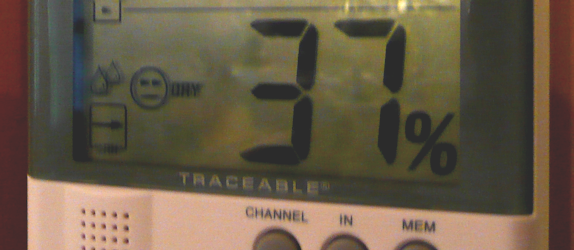It’s Not the Heat…

It’s not the heat…it’s the humidity.
After taking time off to reorganize the shop and to make some new woodworking jigs and fixtures, I was ready to begin construction of some new instruments. It was at this point that I realized that the humidty in the shop was lower than expected and fluctuating, with the higher end of the range at only 37%. I determined that the humdifier unit was no longer working and the heat, which is still on in this very cold spring we’re having, was drying out the air.
Why does humidity matter? The seasoned wood used to make an acoustic instrument shrinks and expands in response to the amount of water vapor in the air — measured and referred to as relative humidity.
I normally keep shop humidity between 40 to 45%. As the wood in a guitar will continue to move even after it has been braced and the body enclosed, building within this range will minimize the amount of movement that occurs later when the instrument is stored and played in an indoor environment whose humidity is set for what is considered to be a comfortable range for people.
As an example of the importance of this, imagine building a guitar in the Amazonian rainforest where the average humidity might be 90%. As long as the humidity remained at 90%, the guitar would move very little. But if this same guitar was destined to reside in the same indoor space described above, the movement of the wood would be extreme to the point that cosmetic and structural failures would occur. The opposite is true as well, if you were commissioned to build an instrument destined to reside outside in the Amazonian rainforest then you would want to match that high humidity range in the shop, at least in the period of time when constructing and enclosing the body of the guitar.
A new humidifer unit has been ordered and is on the way. I expect to be back up and running by week’s end.
